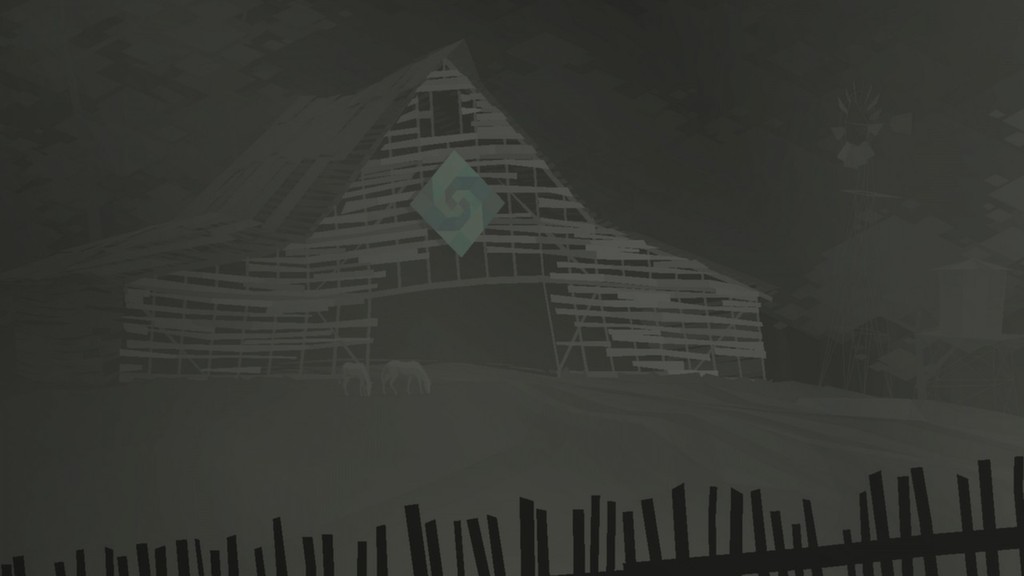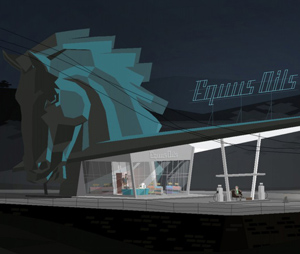We’ve all been there, right? It’s getting late. You’re driving down a lonely stretch of countryside, trying to find that one road that isn’t on the map. The deeper you get into the territory, the more uneasy it feels, seeing stray roads that lead who knows where, and you wonder if you should have just turned around and gone home on the main stretch. But what if you did go down one of those unusual roads? Such is the idea behind the first episode of Kentucky Route Zero, a “magical realist adventure” from the minds at Cardboard Computer where, on a quiet evening in the back country of Kentucky, a weathered but good-natured delivery driver named Conway rolls up in his antique of a pickup with his straw-hat-wearing dog at an odd oil and gas station in the middle of nowhere, asking an old blind man directions to a “5 Dogwood Drive.” He is informed that the address in question is on “the Zero,” a mysterious highway conspicuously absent from his map. After getting directions to someone who knows how to find it, Conway gets his first taste of how strange and extraordinary his journey is about to get, which quickly escalates into Twilight Zone territory.
At first glance this is a contradiction of terms from the description of the game provided by Cardboard Computer, which puts it as realism rather than surrealism. But the story you experience in this first episode of a multipart journey has a few surprises, and that is the heart of the genius at work in this game. At the beginning you are asked by the old blind man at the gas station if you heard about a wreck that occurred only hours before that spread glass all over the highway, and you are immediately tempted to connect this to Conway and his delivery truck, and that he might be dead. However, one of the best aspects of Kentucky Route Zero is its ability to throw you little curveballs against what feels like veiled fact. This brings us back to the realist nature of the game, one that isn’t hampered by complex puzzles and confusing pathways but is, like Dear Esther, a more pure story experience that does require a little bit of puzzle-solving but nothing requiring rocket science. It is through this puzzle-solving that we get to see parts of the game that we would otherwise miss.
From the get-go, fans of old-school adventures and minimalist storylines (not to mention minimalist graphics) will immediately be drawn into the world of Kentucky Route Zero, brought to life by its classic style of 3D animation that hearkens back to the days of games like Another World and Flashback. Blocky, polygonal character models sport a somewhat caricaturized but effective appearance against a backdrop of much higher detail, where structures and scene details are well thought out and placed. The art direction goes a step further in its atmospheric expression by introducing certain blink-and-you-miss-them visual elements when you turn off Conway’s lantern.
But the game isn’t just a series of interconnected scenes, as are common in traditional adventure games. The game also lets you drive Conway’s delivery truck to whatever route you need to get to via a black and white overworld, which is in the form of a road atlas with the truck represented by a single wheel that spins as you move. Certain landmarks that show up along this view aside from the main story path can be also visited, but remain text-based in their description and interaction. For instance, you come upon an old white church where loud singing is heard. Upon choosing the appropriate dialogue options, you find that the church singing was nothing more than a reel-to-reel tape player squelching old hymns to nothing but an empty space. Sites like this are found by what feels like accidentally on purpose, where you feel you were somehow guided there without really looking for them. While the world is largely contemporary and realistic, even the oil and gas station at the beginning of the game manages to make it fantastical and surrealist, reminding us that photorealism is just a sub-category of quality visuals.

Unfortunately, not everything is executed in a manner that keeps us steeped in intrigue. Interaction with characters comes in the way of several unique dialogue choices with each new situation that serve as an opportunity for the player to give Conway a bit of their own personality. With each odd situation (and 100% of them are odd), we are treated to some quirky responses and situations that don’t entirely make sense. While that helps the intrigue, the dialogue is very flat and boring, “on the nose” as screenwriters would say. While the developers wanted a minimalist approach, they could have done more with the dialogue to give it some pep. Characters do not speak with any kind of vernacular speech as would be especially noticeable in the American south. One could theoretically read this kind of thing into the characters, but the dialogue and even the art direction fails to meet the player half-way and thus we tend to find ourselves wishing it had that something extra. Despite this, the dialogue does do a good job of informing the player of their surroundings and its lore, even though it never even comes close to asking the question of why Conway would go through all this just for a routine delivery.
This isn’t to say that the characters themselves aren’t interesting, as the developers did a good job of giving us characters we can endear ourselves to. Conway proves to be a likeable character from the start, having kindly taken in an old and weathered dog on its last legs as a traveling companion. The amiable old blind man comments on the beautiful sunset despite facing the wrong direction. Even the bland-talking TV repairwoman gets some feeling out of the player as she tells of her parents breaking themselves in the old mine.
All of this is accompanied by an almost tangible and ambient silence that makes you feel like you’re in Kentucky with these characters. Conway’s journey is also tinged with occasional music motifs by game composer Ben Babbit. In addition, the game includes a host of bluegrass and classic gospel hymns performed by the Bedquilt Ramblers.
Kentucky Route Zero is a game of ambience and adventure, where minimalism is used in almost all the right ways to make this experience as real and engrossing as possible. Although players who are looking for well-scripted and path-altering dialogue between characters will be disappointed, the rest of the game more than makes up for the lack of personality and emotional depth that may very well be present in subsequent entries of the series. When all is said and done, this is a fantastic ride into uncharted territory with a surprise ending that makes us rev up for more.
Rating: 7.8/10
Read on for Review of Kentuck Route Zero Act II





